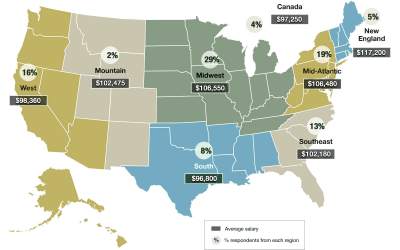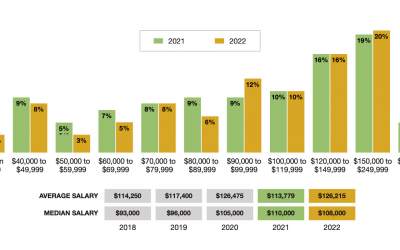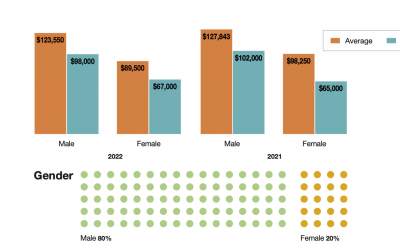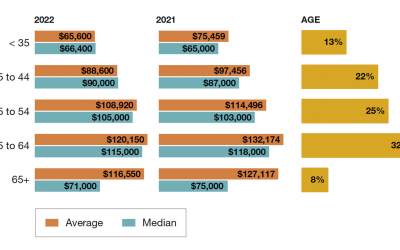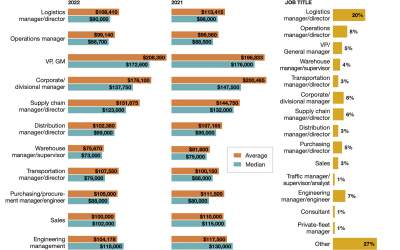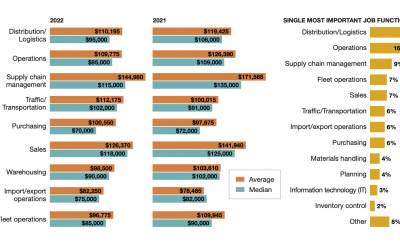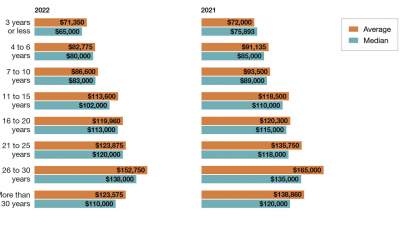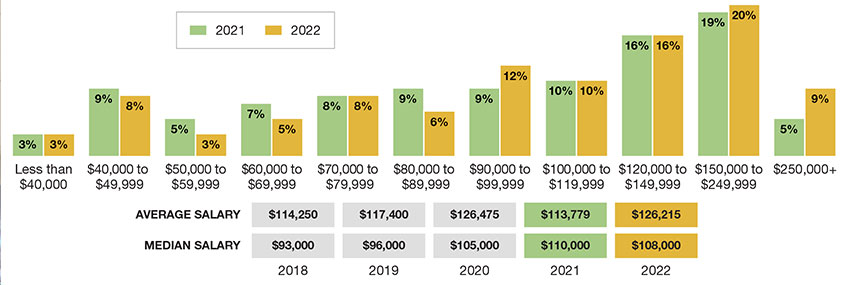38th Annual Salary Survey: Salaries begin to rebound
A confluence of factors—labor demand that’s outpacing supply, worker retention challenges, rising e-commerce sales, supply chain shortages, and relatively healthy economic conditions—have led to a rebound in supply chain salaries.
It’s no secret that demand for labor has completely outstripped supply in the current market, where sub-4% national unemployment rates only tell part of the story. In warehouses, distribution centers (DCs) and other logistics operations across the nation, unemployment rates are often lower than the national averages, open positions languish on the job boards, and current employees keep their eyes peeled for the “next best thing”—just in case.
All of this is happening within the context of a sharp increase in e-commerce sales, fairly robust economic conditions, and persistent supply chain shortages, all of which are working in opposition to make life difficult for the typical logistics, warehouse or supply chain manager right now.
“The transportation and logistics sector has been particularly hard hit,” McKinsey & Co., reports, “with the impact of worker-retention challenges and rising labor costs being felt across the entire value chain.”
The research firm says this pervasive “labor mismatch” has driven up private-sector wages to rates that are more than double the long-term, pre-pandemic growth rates, and yet positions still remain unfilled.
In other words, even higher wages aren’t helping to fill the widening gap between open positions and candidates that can fill them. “Despite wage increases, logistics operations are still having difficulty hiring and retaining frontline workers,” McKinsey states, “while also seeing increased absenteeism, causing knock-on effects across the supply chain.”
What is your current total annual salary for 2022?
(Includes bonuses and commissions, etc.)
In an effort to find out more about these factors and also give supply chain leaders an inside look at exactly what’s going on behind the scenes at the typical logistics operation right now, Peerless Research Group (PRG), the research arm of Peerless Media, conducted a new “Compensation and Executive Education Study” in February of 2022. Nearly 300 Logistics Management readers participated in the online survey.
Salaries are up across the board
On average, supply chain and logistics professionals are making $126,215 annually in 2022, which is an increase from $112,779 in 2021, but on par with 2020’s average of $126,475. The median salary in 2022 is now $108,000.
Twenty percent of supply chain professionals earn between $150,000 and $249,999 annually, while 16% earn between $120,000 and $149,999. Twelve percent of respondents earn between $90,000 and $99,999, and 10% earn $100,000 to $119,999. At the higher end of the scale, 9% of supply chain professionals earn more than $250,000 a year.
Logistics Salary by Gender
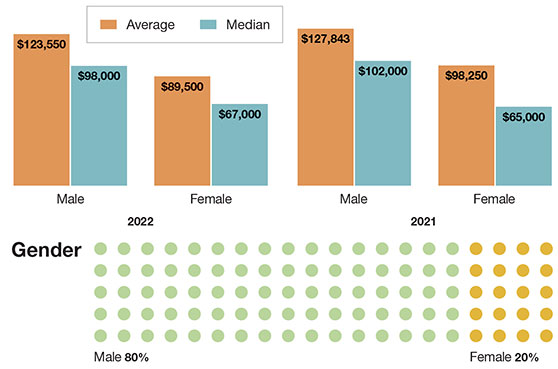
Over the past 12 months, 64% of professionals said their salary level has increased, while 32% said their salary level has stayed the same, and 4% said it has decreased. When asked how much their salaries have changed, the average increase was 8% and average decrease was 19%.
Of the nearly 300 responses received, 80% were from male respondents and 20% from female participants. Based on the responses, it’s clear that a gender pay gap exists. For example, men reported an average salary of $123,550 annually while the average for women supply chain professionals was $89,500.
Exploring the results
Survey respondents represented regions across North America, with 29% residing in the Midwest, 19% in the Mid-Atlantic, 16% in the West, and 13% in the Southeast. Eight percent live in the South, 5% live in New England, 4% in Canada, and 2% in the Mountain States.
Breaking the results down by region, professionals in New England earn the most with an average of $117,200, followed by the Midwest with an average salary of $106,550. Respondents in the Mid-Atlantic earn $106,480 on average, those in Mountain States earn $102,475 on average, and Southeastern professionals earn $102,180 annually.
The lowest earners are located in the South, with an average of $96,800, followed by Canada with an average of $97,250, and Western states with an average of $98,360 in 2022.
The ages of the survey participants varied, with 32% being between 55 years old and 64 years old, 25% between ages 45 and 54, and 22% between ages 35 and 44. Thirteen percent were under 35 years old, and 8% were over 65 years old.
Salary by job title
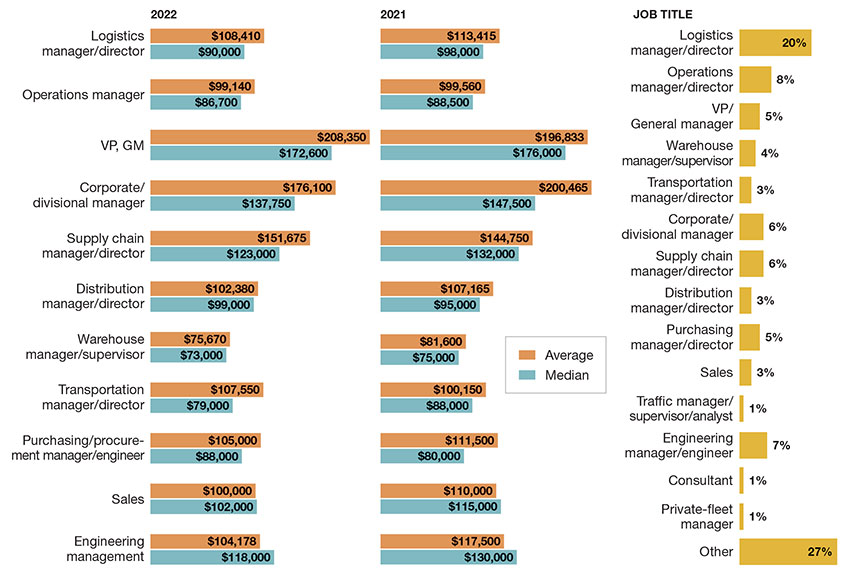
Based on the survey results, it’s evident that annual supply chain salaries increase with age and tenure. Respondents between 55 and 64 reported an annual salary of $120,150 in 2022, while the 45 to 54 age group reported an average salary of $108,920, and those between the ages of 35 and 44 indicated an average salary of $90,000. Respondents over 65 earn an average of $116,550, and those under 35 are earning $65,600, on average.
Transportation is critical
Twenty percent of respondents for this year’s survey were logistics managers or directors; 6% were operational managers or directors; 6% were corporate or divisional managers; and another 6% were supply chain managers or directors.
On average, VPs and general managers post the highest annual salaries of $208,350 (up from $196,833 in 2021), followed by corporate or divisional managers with an average salary of $176,100.
Other job titles have also experienced significant salary increases, including transportation managers and directors who reported an average salary of $107,550 in 2022, up from $100,150 in 2021, and supply chain directors and managers, who reported an annual salary of $151,675 in 2022, versus $144,750 the prior year.
Salary by most important job function
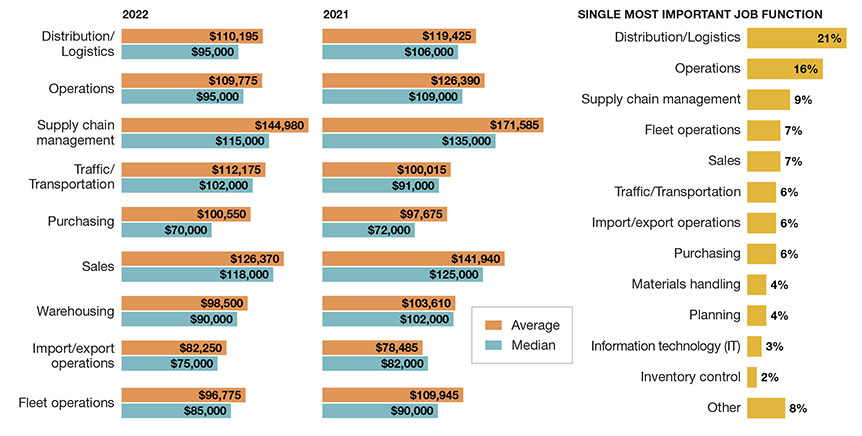
Asked to name their single most important job responsibility, 21% of survey participants pointed to distribution and logistics, while 16% said operations and 9% said supply chain management. Others said that fleet operations (7%) was their most important function, while 7% said sales, 6% pointed to traffic and transportation, 6% said import and export operations, and another 6% said purchasing.
Anyone primarily involved in supply chain management reported the highest salary average in 2022 of $144,980, followed by sales with an average of $126,370. The two primary job functions that saw an increase in salary from 2021 were traffic and transportation, and import and export operations, most likely due to how vital these functions have become in the midst of the current supply chain challenges.
On average, individuals who work in traffic and transportation are earning $112,175 in 2022, compared to $100,015 in 2021. Similarly, respondents whose primary job focus is on import and export operations reported an average of $82,250 in 2022, up from $78,485 the prior year.
Respondents working in the manufacturing sector report the highest average salary of $114,320, followed by distributors, who earn $110,480 on average. Those in consulting earn around $106,875 annually, while third-party logistics (3PL) employees earn $102,250 on average.
Wholesale trade employees earn about $95,350 and retail trade employees earn $93,235.
Filling in the gaps
Many respondents are employed by manufacturing organizations (41%), followed by wholesale trade (11%), and distributors (11%). Others work in retail trade (9%), while 8% work for a 3PL, and 3% work in consulting.
As supply chain disruptions continue, 72% of professionals said the number of functions they perform on the job has increased in the last two to three years. Just more than one-quarter of readers said their number of functions have stayed the same, and only 2% said they have decreased.
When asked how many years they’ve been in their current position, 31% of survey participants said they’ve held their position for three to five years, while 23% have been in their current positions for more than 10 years. Others have held their current positions for 1 year to 2 years (21%), 6 years to 10 years (16%) or less than one year (10%).
Salary by years of logistics/supply chain management experience
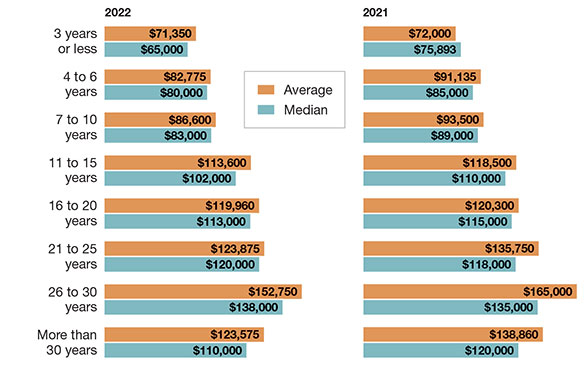

When asked how many years of logistics and/or supply chain management experience they have, 17% of respondents said 11 years to 15 years, 15% said more than 30 years and 12% have less than 10 years of experience in the field. Forty-six of respondents said they’re “always open” to better job opportunities, while 31% are happy where they are, 20% are passively looking, and 3% are actively looking.
Respondents who are happy where they are earn $124,535 on average, while those who are actively looking earn $108,560 on average. However, those who are “passively looking” and those who are “always looking” have similar annual incomes of $118,540 and $118,890, respectively.
Advancing their careers
Forty-one percent of this year’s respondents say that they hold a bachelor’s degree, while 23% have completed some college, 12% hold an MBA degree, and another 10% have earned their graduate degrees. Eight percent have completed an associate’s degree, 5% have finished high school, and 2% have a non-degree education.
About 37% of all respondents have completed a formal education in logistics and/or supply chain management, while 63% have not. Individuals who have completed a formal supply chain or logistics education earn an average salary of $110,135. Those who have not completed this type of education earn an average of $99,965 annually.
What would you say have been the most important steps in advancing your career?
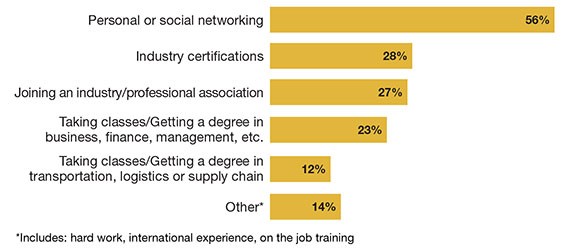
Asked to reveal their most effective career-advancement efforts, 56% of respondents pointed to personal or social networking, while others said industry certifications (28%) or membership in an industry or professional association (27%).
Another 23% said taking classes or getting a degree in a business field has helped them advance in the supply chain field, while 12% said taking classes or getting a degree in transportation, logistics or supply chain specifically. Finally, 14% said success in this field comes from hard work, international experience or on-the-job training.

Article Topics
Photos News & Resources
32nd Annual Study of Logistics and Transportation Trends: Navigating a shallow pool of resources 2023 LTL Study: Partner for reliability 2023 Logistics Salary Survey: Strong numbers, high demand 2023 Warehouse Equipment Survey: Tighter budgets prompt targeted spend 2022 Less Than Truckload Study: Trials and tribulations of rising rates 38th Annual Salary Survey: Salaries begin to rebound 2021 Warehouse/DC Equipment Survey: Preparing for post-pandemic volumes More PhotosLatest in Logistics
Understanding the FTC’s ban on noncompetes UPS rolls out fuel surcharge increases U.S. rail carload and intermodal volumes, for week of April 20, are mixed, reports AAR Baltimore suing ship that crashed into bridge, closing port, costing jobs Intermodal growth volume remains intact in March, reports IANA Descartes announces acquisition of Dublin, Ireland-based Aerospace Software Developments Amid ongoing unexpected events, supply chains continue to readjust and adapt More LogisticsAbout the Author
Subscribe to Logistics Management Magazine

Find out what the world's most innovative companies are doing to improve productivity in their plants and distribution centers.
Start your FREE subscription today.
April 2023 Logistics Management

Latest Resources


